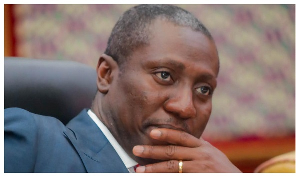The Director General of the National Development Planning Commission (NDPC) Prof. George Gyan Baffour has said Ghana is likely not to achieve all of its Millennium Development Goals (MDGs) by the year 2015.
He said the attainment of the MDGs would depend on effective integration of the goals into the national development agenda as well as a very constructive relationship with development partners.
Prof. Gyan Baffour said these at the launch of the Millennium Project Report in Accra last Tuesday. He also said Ghana was gradually integrating the MDGs into her national development agenda with some of the goals making significant improvements.
"The on-going revision of the Ghana Poverty Reduction Strategy (GPRS), for the 2006 to 2009" period which is due in June, is a major avenue for ensuring effective integration of the MDGs into the national agenda," he said.
Giving an overview of the progress made so far by Ghana on the MDGs, he explained that in the case of the first goal, that is halving poverty and hunger by the year 2015, the proportion of children underweight was 27 percent in 1992. This declined to 25 percent in 1999 and 23.3 percent in 2003.
"Using a linear projection of the 2015, value, the prevalence of underweight children will be 21 as against a target of 14," adding," this clearly indicates that the country may not be able to reach this target."
On the second goal that is, achieving universal education, Prof. Gyan Baffour explained that the net primary school enrolment was 58 percent in 1999 and 69 percent in 2003.
He said a linear projected 2015 target would be 82.8 percent as against a target of 100 percent.
On the third goal, which is to promote gender equality and empower women, he said the proportion of female enrolment in primary schools to male ratio increased from 0.82 percent in 1990 to 0.87 in 1996 and then to 0.90 in 2000.
"This goal can only be achieved by scaling up investment on interventions for promoting girls education," Prof. Gyan Baffour noted.
On the Millennium development Goal number four geared, which is reducing child mortality, he explained that under five child mortality in Ghana was 155 per 1000 live births, but this declined to 100 per 1000 live births in 2002, according to the Human Development Report of 2004.
"However judging from the current trend, under five mortality 78 per1000 is unlikely to be achieved," he said.
On Goal number five, that is aimed at improving maternal health, the target was to reduce maternal mortality levels in 1990 by two-thirds. The trend was 280/100,000 births in 1993, declining to 250/100,000 in 2003
Thus by the year 2015, maternal mortality should decline to 54/100,000 live births.
Here Prof. Gyan Baffour said on the current pace the target is unlikely to be met.
On goal number six, which is geared towards combating HIV and malaria as well as other diseases, Prof. Gyan Baafour explained that in 1990 three percent of the adult population was infested with the HIV virus. This has increased to3.6 in 2003.
"Although a lot of effort has gone into combating HIV/AIDS and malaria, the trend indicate that the country is unlikely to meet these targets," he said.
On MDG number seven, which is to ensure environmental sustainability, he said access to safe water rose from 49 percent in 1990 to 74 percent 1998 and to 74.1 percent in 2003.
He was however happy that Ghana could meet the target for safe water by 2015.
On Goal number eight which is geared towards developing a global partnership for development, he said the target is to ensure that debt service to GDP ratio was reduced to a sustainable level.
"Ghana's debt service to GDP ratio was 6.2 percent in 1990 and 2.4 percent in 2002," Prof. Gyan Baffour said adding, the HIPC initiative has helped to contain Ghana's debt situation and if the current trend continues, then the country can maintain sustainable debt levels."
Prof Gyan Baffour further explained that poverty declined from 52 percent in 1992 to 40 percent in 1999 representing a decline of 1.8 percent per annum.
He said based on a linear projection, the proportion of the population that will be below the poverty line will be around 9.2 percent to 12 percent by 2015 compared to a target of 20 percent," "The proportion below extreme poverty will be 4 percent by 2015 below a target of 18 percent", he said.
According to him, 21 billion dollars is needed over the next 10 years to fund the implementation of the MDGs. This he said translates into an annual resource requirement of 2.1 billion dollars.
"Assuming that most of the resources needed will be for investment in schools, hospitals, irrigation equipment etc, and gain assuming that about 60 percent of our investment budget is obtained from donor sources locally and outside, this implies a 13 billion dollars financing gap over the next 10 years," he said.
Total resource required for poverty and hunger for the ten-year period is $3,743 million with an annual requirement of $374m.
Education requires $4,695m over the same period with an annual requirement of $470.
Gender Equality requires $565million, with an annual need of $57million, while Health require $4,981million with an annual need of $98million.
In addition, Environment sector $4,268 million with an annual requirement of $427 million.
Water and Sanitation has $1,963 million requirement over the next 10 years has an annual requirement of $196million.
Environmental sustainability such as slum upgrading has $650million requirement over the 10 year period with an annual requirement of $650 million.
The Minister of State in Charge of Economic Planning Dr. Samuel Nii Noi Ashong said for the Millennium Development Goals to be achieved, the country needs a major breakthrough.
"Actions on both sides of the development divide would have to be swift and concrete," he said, "adding, "we count on the unwavering support of our partners honouring their commitments under the global compact by raising and improving development assistance, adopting wider and better debt relief policies, fair trade agreements, improving market access and fostering technology transfer would help catalyst our national effort."
According to the Millennium Project Task Force on Trade, opening up trade between developed and developing countries can be a powerful tool for economic development.
To make the trading system more balanced in favour of developing countries can offer opportunities for economic growth and poverty reduction, disease and environmental degradation in developing countries," the Task Force said in a report issued in New York last Monday.
Click to view details



Business News of Sunday, 23 January 2005
Source: Public Agenda
















